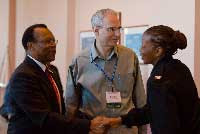Posted by Joan Rachlin, executive director
 “Connection,” that “what-does-it-really-mean” word. I am a seeker and supporter of connections, and would like to share with you a few thoughts on this avocation of mine.
“Connection,” that “what-does-it-really-mean” word. I am a seeker and supporter of connections, and would like to share with you a few thoughts on this avocation of mine.
By day, I masquerade as PRIM&R’s executive director, but by night I morph into an inveterate collector of other people’s stories. “Does this,” you might ask, “have anything to do with research ethics or protecting human subjects?” Well, I guess it depends who you ask…I would argue that it does, at least in the sense that everything is connected.
For starters, listening—really listening—to those in our personal or professional lives is a sign of respect, which is, after all, the first Belmont principle. Secondly, respectfully listening to someone helps breed trust, which is an essential ingredient of all strong and ethically-rooted relationships. Thirdly, learning more about someone and their stories can breed empathy, which in turn leads to greater caring and compassion. In today’s fast-paced healthcare environment, most researchers and/or clinicians don’t have time to thoughtfully listen to patients and/or subjects. Without listening, though, it’s hard to develop meaningful connections.
In some sub-specialties, there’s not even an opportunity to listen, e.g., pathologists and most radiologists never even meet their patients. Hungry for a connection with the “folks behind the films,” one radiology resident designed a study in which he attached photographs of the patients to their MRI, CT, and other films. His study showed that radiologists’ reports are much more detailed and comprehensive when they have photos of the patients in front of them as they read the films. This research was described in a story in the New York Times and concluded that the radiologists in the study, most of whom were disconnected from real, live patients, felt more like doctors when they had a photo in front of them. They reported a sense of connection with their patients and further reported that this connection improved the quality and focus of their work.
Might there be a parallel between the radiologist’s quest and the work of the IRB? Few IRBs professionals have the chance to meet research subjects, although there might be an occasional subject sitting on your committee as the non-scientific member. But have you ever sat, really sat, and listened to first-hand accounts of their stories? Have you ever had the luxury of establishing the kinds of connections with subjects that have made you see things differently? Maybe IRBs should have photos of some prospective subjects appended to the respective protocol so that they, too, have a sense of the “people behind the protocol?”
Photos are but one way to create connections. A recent feature from one of my favorite NPR programs, Story Corps, forced me to pull my car over, as I could no longer safely drive through my tears. The story centered on Hawaii-native Alan Hoe, whose son was killed in Iraq four years ago. Mr. Hoe decided to spend Memorial Day at the Vietnam Memorial in Washington, D.C. and brought some Hawaiian leis with him. While there, he met the nurse who tried to save his son’s life and the connection that arose between them was beyond powerful. Have a look or listen, and think about what would have been lost if the connection in this story had not been made.
PRIM&R is blessed by having deep and wide connections with many people in our community, and we urge those of you who would like to be more connected to PRIM&R, to e-mail us so that we can figure out ways in which that might happen.
I’d also like to hear what the word “connection” means to you. Are you doing anything to build or strengthen the connections in your lives? Have you had encounters with research subjects or their families that shook your foundation, even a little? If so, please share some of your “connection” stories with our members via the “comments” section on this blog. Thanks, and have a good weekend!

Nice post. I am slowly building out my blog and I appreciate your insight into listening. I am a collector of stories myself and also spend a lot of time researching storytelling in general.
My goal is help facilitate telling. To do this I have to be dedicated to listening myself, else I cannot help others find their story.
Thank you for sharing.